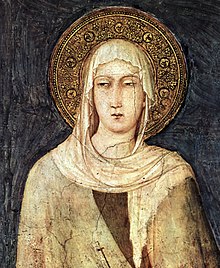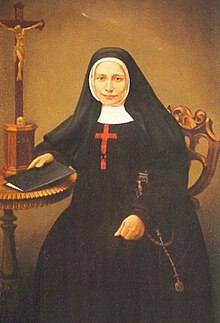Talk:Order of Friars Minor/Deleted Content
- There are three main orders of Catholic Franciscans, with their subdivisions.
First Order
[edit]| This article may require cleanup to meet Wikipedia's quality standards. The specific problem is: Some of this content was incorrectly placed outside of this subsection, and needs revision for accuracy, clarity, cohesion, and consistent formatting. Please help improve this article if you can. |
The First Order or the Order of Friars Minor are commonly called simply the Franciscans. This order is a mendicant religious order of men, some of whom trace their origin to Francis of Assisi.[1] Their official Latin name is the Ordo Fratrum Minorum.[2] St. Francis thus referred to his followers as "Fraticelli", meaning "Little Brothers". Franciscan brothers are informally called friars or the Minorites.[3]
- The "Observants", most commonly simply called Franciscan friars,[1] official name: "Friars Minor" (O.F.M.).[3]
- The Order of Friars Minor Capuchin or simply Capuchins,[1] official name: "Friars Minor Capuchin" (O.F.M.Cap).[3]
- The Conventual Franciscans or Minorites,[1] official name: "Friars Minor Conventual" (O.F.M.Conv).[3]
Second Order: Poor Clares
[edit]
The Second Order or the Order of St. Clare (O.S.C.) consists of religious sisters. The order is most commonly called the Poor Clares in English-speaking countries, although prior to 1263 this order was referred to as the Poor Ladies, the Poor Enclosed Nuns, and the Order of San Damiano.[4]
The Poor Clares comprise several monasteries of Catholic nuns. The Poor Clares were the second Franciscan order to be established by Saints Francis of Assisi and Clare of Assisi.
Third Order
[edit]
During his lifetime, many married men and women and even clergy and hermits were drawn to the vision of life offered by Francis, but due to their life commitments, they were not able to enter the Friars Minor or the Poor Clares. For this reason, he founded a way of life to which married men and women, as well as the single and the secular clergy, could belong and live according to the Gospel. According to the traditions of the order, the original Rule was given by Saint Francis in 1221 to a married couple, Luchesius Modestini and his wife, Buonadonna, who wished to follow him but did not feel called to separate as a married couple. After founding the Friars Minor and seeing a need, Francis created the "Brothers and Sisters of Penance" (now known as the Secular Franciscan Order.)
The Franciscan third order has many men and women members, separated into two main branches:
- The Secular Franciscan Order, OFS, originally known as the Brothers and Sisters of Penance, try to live the ideals of the movement in their daily lives outside of religious institutes.
- The members of the Third Order Regular (TOR) live in religious communities under the traditional religious vows. They grew out of the Secular Franciscan Order.
Secular Franciscan Order
[edit]Members of the Order live according to a Rule composed by St Francis in 1221. The Rule was slightly modified during the centuries to be adapted to the changing times and replaced at the turn of the 20th century by Pope Leo XIII, himself a member of the Order. A new and current Rule was approved by Pope Paul VI in 1978, and the Third Order was renamed the Secular Franciscan Order. It is an international organization with its own Minister General based in Rome.
Third Order Regular
[edit]
Within a century of the death of St. Francis, members of the Third Order began to live in common, in an attempt to follow a more ascetical way of life. The Blessed Angela of Foligno (+1309) was foremost among those who achieved great depths in their lives of prayer and service of the poor, while living in community with other women of the Order.
Among the men, the Third Order Regular of St. Francis of Penance[5] was formed in 1447 by a papal decree that united several communities of hermits following the Third Order Rule into a single Order with its own Minister General. Today it is an international community of friars who desire to emphasize the works of mercy and on-going conversion. The community is also known as the Franciscan Friars, T.O.R., and They strive to "rebuild the Church" in areas of high school and college education, parish ministry, church renewal, social justice, campus ministry, hospital chaplaincies, foreign missions, and other ministries in places where the Church is needed.[6]
Following the formal recognition of the members of religious tertiary communities, the following centuries saw a steady growth of such communities, across Europe. Initially, the women's communities took a monastic form of life, either voluntarily or under pressure from ecclesiastical superiors. The great figure of this development was St. Hyacintha Mariscotti, T.O.R. As Europe entered the upheavals of the modern age, new communities arose, which were able to focus more exclusively on social service, especially during the immediate post-Napoleonic period, which devastated much of Western Europe. An example of this is the Blessed Mary Frances Schervier, S.P.S.F.
This movement continued in North America, as various congregations arose from one coast to another, in answer to the needs of the large emigrant communities, flooding in the cities of the United States and Canada.
Copied by --Zfish118⋉talk 17:26, 26 November 2016 (UTC)
- ^ a b c d "The rule of the Franciscan Order from the Medieval Sourcebook". Fordham.edu. 1999-09-22. Retrieved 2013-06-16.
- ^ Paschal Robinson (1913). . In Herbermann, Charles (ed.). Catholic Encyclopedia. New York: Robert Appleton Company.
- ^ a b c d Paschal Robinson (1913). . In Herbermann, Charles (ed.). Catholic Encyclopedia. New York: Robert Appleton Company.
- ^ See Maria Pia Alberzoni, Clare of Assisi and the Poor Sisters in the Thirteenth Century (St. Bonaventure, NY: Franciscan Institute, 2004).
- ^ "Third Order Regular". Francescanitor.org. 2013-05-12. Retrieved 2013-06-16.
- ^ Franciscan Friars, TOR. "The Franciscan Orders". Archived from the original on 2007-06-17. Retrieved 2007-07-10.
